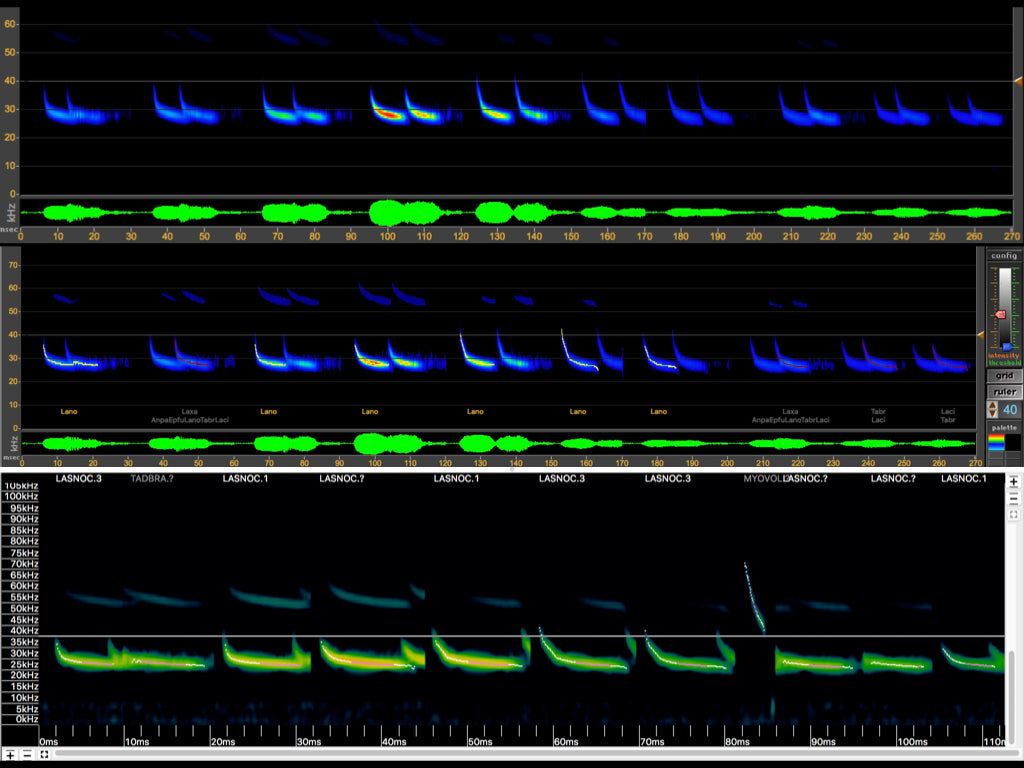Never underestimate the perils of a hasty deployment when recording bat echolocation calls in full-spectrum (or zero-cross, for that matter). The image accompanying this post is one such example: A lovely isolated mountain lake, surveyed with a borrowed painter’s pole using a popular “lock jaw tool holder” attachment. Sadly, in the haste to set up in time for a memorable sunset deployment photo, the microphone was inserted into the lock-jaw attachment backwards, so when elevated, instead of angling slightly up, it angled slightly down toward the reflective water surface. The results were predictable: A survey’s worth of echo-ridden recordings, many of which were unusable for computer-aided species identification.
Sometimes the echo was terrible, over-lapping the original echolocation call pulses entirely. Sometimes echo merely masked the end of the call pulses. And, other times it was present completely within the silence between call pulses. Three such examples are illustrated in the attached figures. All of these situations can interfere with accuracy from computer-aided identification results, and the effects of the interference can differ, depending on which display and/or analysis software is used.
Zero-cross display and analysis can make it difficult to identify overlapping or near-overlapping echo. The “enhanced zero-cross” analysis available with the signal parameters toggle in Kaleidoscope does a pretty good job of sorting through echo to provide accurate trend-lines for zero-cross analysis. And, the full-spectrum algorithms in SonoBat do a great job of resolving pulse-level metrics and trend-lines for analysis, but much of the time echo causes pulses to be rejected by SonoBat’s post-classification, call-quality checks. The best option is to avoid recording echo-laden call sequences entirely.
How to prevent echo?
Echo can happen during any acoustic deployment and can never be completely eliminated, but it can be much reduced by considering these echo-minimizing tips:
- Elevate microphones at least 16-feet above ground level (so echo falls within the silent spaces between pulses)
- Angle microphones at 45-degrees above a horizontal plane
- Deploy over non-reflective surfaces (e.g., vegetation), or at least 20-feet from the water’s edge
- Use a microphone mast with as small a surface area as possible and/or a textured, non-reflective surface
Carrying appropriate deployment gear into the field that meets all of these considerations isn’t always convenient. One easy solution is the “20-foot Survey Mast” available from Bat Conservation and Managment. A microphone can be securely mounted to the top of the mast with simple #64 rubber bands. No fancy zip-ties, sticky tape, or bulky lock-jaw attachments are needed. Consider purchasing long-life EPDM non-latex bands for multi-day deployments (e.g., Alliance brand X-treme File Bands). And remember: An ounce of prevention is worth a pound of cure.

Figure 1: Top-An example of overlapping echo causing constructive and destructive interference; Middle-SonoBat pulse-level classifications and trend-lines; Bottom-KaPRO pulse-level classifications and trend-lines. Neither program could provide a confident classification for this sequence.

Figure 2: Top-An example of interfering echo causing pulses to appear longer in duration than they actually are; Middle-SonoBat pulse-level classifications and trend-lines; Bottom-KaPRO pulse-level classifications and trend-lines. Neither program could provide a confident classification for this sequence.

Figure 3: Top-An example of echo appearing mostly within the silent spaces between pulses; Middle-SonoBat pulse-level classifications and trend-lines; Bottom-KaPRO pulse-level classifications and trend-lines. Both programs provided a confident LASNOC classification for this sequence.
About Full-Spectrum Fanboy
The Full-spectrum Fan-boy has been studying bats for over 30-years, beginning with a work-study scientific literature databasing project in college that morphed into a career of field work and survey techniques to investigate bat echolocation. He began his acoustic survey activities on one of the first AnaBat platforms for live-recording in the field and has since transitioned to recording and analysis in full-spectrum using a variety of active and passive bat detectors and signal analysis software programs. He envisions a bright future for this technology, but remains wary of its limitations.





